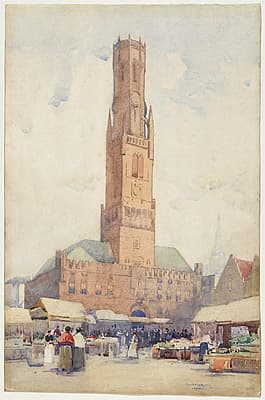
Sydney
LONG
Australia
1871
–
London
1955
England, Europe 1910-21; Australia 1921- 22; England 1922-25; Australia 1925-52; England from 1952
46.0 (h) x 30.0 (w) cm , no manufacturer's mark
signed and dated ‘Sid Long 1914’ lower right National Gallery of Australia, Canberra NGA 2011.975 Purchased 2011 Reproduced with the kind permission of the Ophthalmic Research Institute of Australia.
- Purchased by the National Gallery of Australia, from Philip Bacon Galleries, Brisbane, August 2011.
In the market-place of Bruges stands the belfry old and brown;/ Thrice consumed and thrice rebuilded, still it watches o’er the town/ … Then most musical and solemn, bringing back the olden times,/ With their strange, unearthly changes rang the melancholy chimes,/ Like the psalms from some old cloister, when the nuns sing in the choir,/ And the great bell tolled among them, like the chanting of a friar. (Henry Wadsworth Longfellow, ‘The belfry of Bruges’, 1845)
Long’s watercolour shows a street scene that is filled with market stalls and people gathered in the square. Overlooking the square, is the soaring belfry, tinged pink by the rising sun. The building has three distinct sections, each growing out of the one before. The stillness of the large Gothic building anchors the movement of the townspeople mingling below. In creating his view of the belfry, Long enlarged the tower so it soars higher than it does in reality.
Long later made an etching of this image, The market place, Bruges 1920, which is an example of the way in which he re-worked his paintings into etchings at a later stage.
This 13th-century belfry is Bruges’s most famous landmark, housing a municipal carillon consisting of 47 bells, and located in the historical centre of the city. It was added to the town square in 1240, but was largely rebuilt in 1280 after a fire. The belfry formerly housed the treasury and a library of municipal records, and served as an observation post for spotting fires and other dangers. It is 83 metres high. A carillonneur has been employed to play the bells there since 1604. The carillon itself is played on a keyboard with pedals and large keys.
In the market-place of Bruges stands the belfry old and brown;/ Thrice consumed and thrice rebuilded, still it watches o’er the town/ … Then most musical and solemn, bringing back the olden times,/ With their strange, unearthly changes rang the melancholy chimes,/ Like the psalms from some old cloister, when the nuns sing in the choir,/ And the great bell tolled among them, like the chanting of a friar. (Henry Wadsworth Longfellow, ‘The belfry of Bruges’, 1845)
Long’s watercolour shows a street scene that is filled with market stalls and people gathered in the square. Overlooking the square, is the soaring belfry, tinged pink by the rising sun. The building has three distinct sections, each growing out of the one before. The stillness of the large Gothic building anchors the movement of the townspeople mingling below. In creating his view of the belfry, Long enlarged the tower so it soars higher than it does in reality.
Long later made an etching of this image, The market place, Bruges 1920, which is an example of the way in which he re-worked his paintings into etchings at a later stage.
This 13th-century belfry is Bruges’s most famous landmark, housing a municipal carillon consisting of 47 bells, and located in the historical centre of the city. It was added to the town square in 1240, but was largely rebuilt in 1280 after a fire. The belfry formerly housed the treasury and a library of municipal records, and served as an observation post for spotting fires and other dangers. It is 83 metres high. A carillonneur has been employed to play the bells there since 1604. The carillon itself is played on a keyboard with pedals and large keys.
In the market-place of Bruges stands the belfry old and brown;/ Thrice consumed and thrice rebuilded, still it watches o’er the town/ … Then most musical and solemn, bringing back the olden times,/ With their strange, unearthly changes rang the melancholy chimes,/ Like the psalms from some old cloister, when the nuns sing in the choir,/ And the great bell tolled among them, like the chanting of a friar. (Henry Wadsworth Longfellow, ‘The belfry of Bruges’, 1845)
Long’s watercolour shows a street scene that is filled with market stalls and people gathered in the square. Overlooking the square, is the soaring belfry, tinged pink by the rising sun. The building has three distinct sections, each growing out of the one before. The stillness of the large Gothic building anchors the movement of the townspeople mingling below. In creating his view of the belfry, Long enlarged the tower so it soars higher than it does in reality.
Long later made an etching of this image, The market place, Bruges 1920, which is an example of the way in which he re-worked his paintings into etchings at a later stage.
This 13th-century belfry is Bruges’s most famous landmark, housing a municipal carillon consisting of 47 bells, and located in the historical centre of the city. It was added to the town square in 1240, but was largely rebuilt in 1280 after a fire. The belfry formerly housed the treasury and a library of municipal records, and served as an observation post for spotting fires and other dangers. It is 83 metres high. A carillonneur has been employed to play the bells there since 1604. The carillon itself is played on a keyboard with pedals and large keys.
